A Systematic Review of Nutritional Interventions for Cancer Cachexia
VerifiedAdded on 2022/12/26
|23
|5858
|1
Project
AI Summary
This qualitative research proposal outlines a systematic review to assess the efficacy of various nutritional interventions in mitigating malnutrition and cachexia in cancer patients post-treatment. The study will utilize narrative theory as its methodological framework, focusing on adult cancer patients (18-65 years) who have undergone treatment for a year or more. Data collection will involve a systematic review, followed by narrative synthesis for analysis, categorizing information into key themes representing different nutritional interventions. The research will prioritize studies from developed countries within healthcare settings. Data extraction will be guided by a structured table, and the validity of selected studies will be ensured using critical appraisal tools. The research aims to provide evidence-based nutritional guidance and pave the way for comprehensive cachexia management strategies. The biomedical model will be used to understand the pathological processes, biochemical changes, and physiological implications of cancer, to evaluate the effectiveness of nutritional interventions.
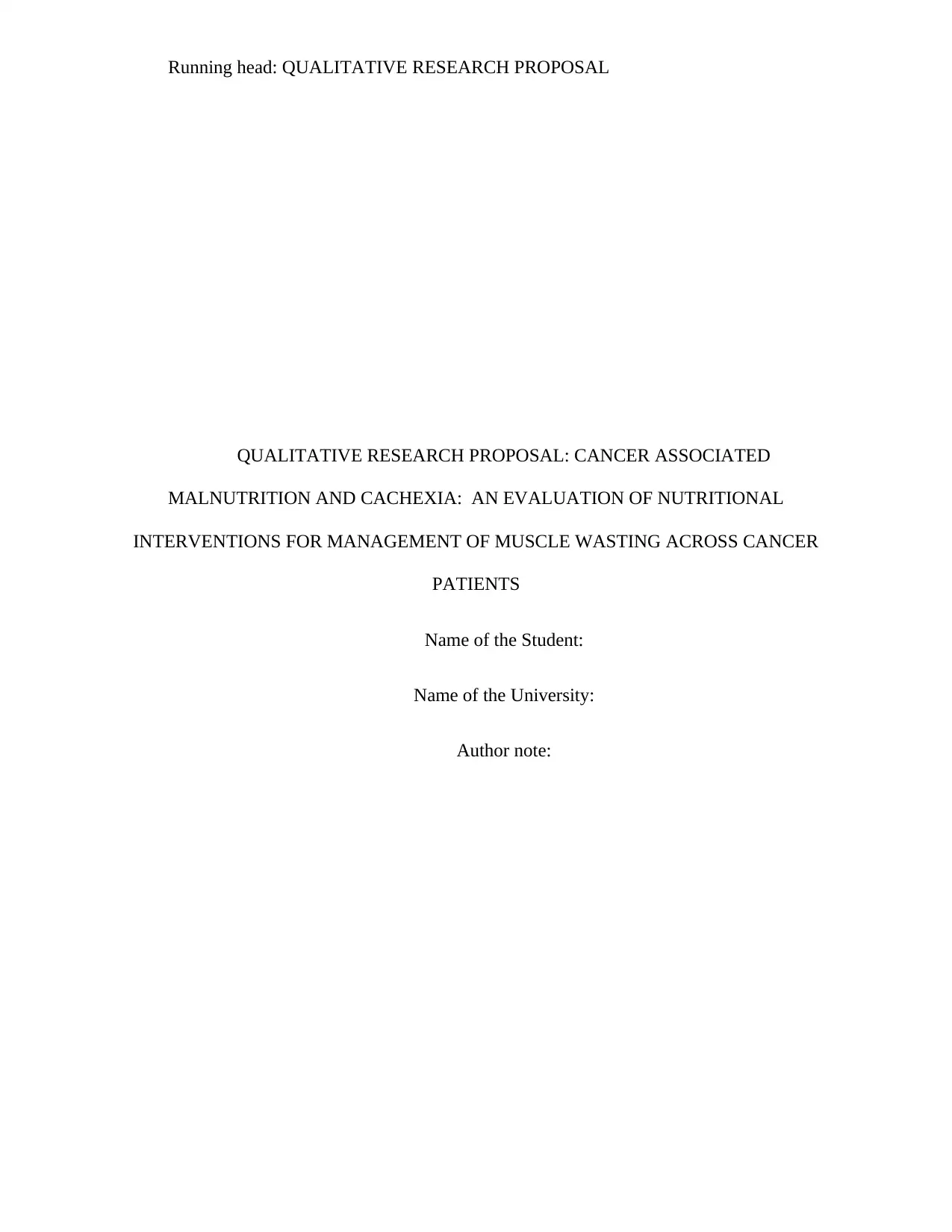
Running head: QUALITATIVE RESEARCH PROPOSAL
QUALITATIVE RESEARCH PROPOSAL: CANCER ASSOCIATED
MALNUTRITION AND CACHEXIA: AN EVALUATION OF NUTRITIONAL
INTERVENTIONS FOR MANAGEMENT OF MUSCLE WASTING ACROSS CANCER
PATIENTS
Name of the Student:
Name of the University:
Author note:
QUALITATIVE RESEARCH PROPOSAL: CANCER ASSOCIATED
MALNUTRITION AND CACHEXIA: AN EVALUATION OF NUTRITIONAL
INTERVENTIONS FOR MANAGEMENT OF MUSCLE WASTING ACROSS CANCER
PATIENTS
Name of the Student:
Name of the University:
Author note:
Paraphrase This Document
Need a fresh take? Get an instant paraphrase of this document with our AI Paraphraser
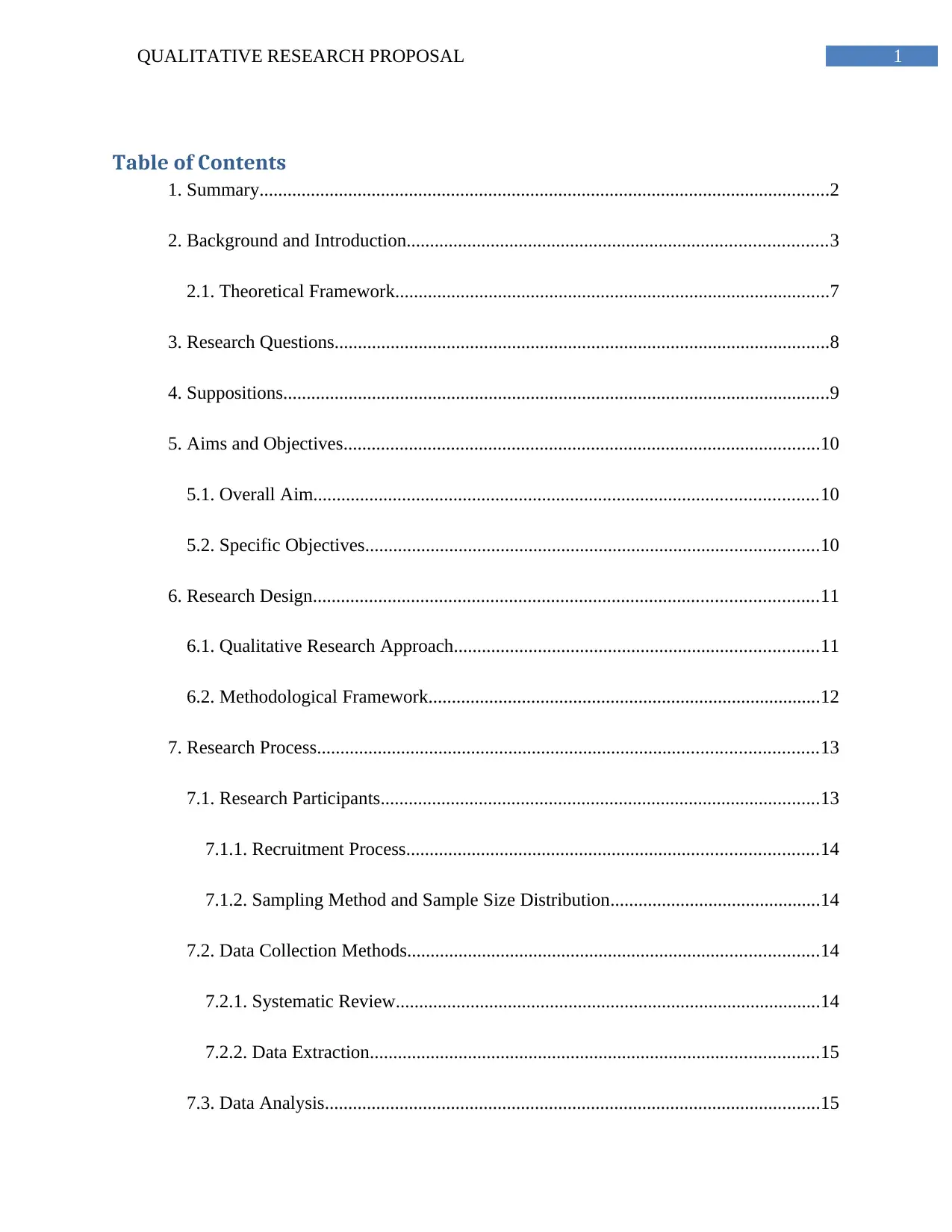
1QUALITATIVE RESEARCH PROPOSAL
Table of Contents
1. Summary..........................................................................................................................2
2. Background and Introduction..........................................................................................3
2.1. Theoretical Framework.............................................................................................7
3. Research Questions..........................................................................................................8
4. Suppositions.....................................................................................................................9
5. Aims and Objectives......................................................................................................10
5.1. Overall Aim............................................................................................................10
5.2. Specific Objectives.................................................................................................10
6. Research Design............................................................................................................11
6.1. Qualitative Research Approach..............................................................................11
6.2. Methodological Framework....................................................................................12
7. Research Process...........................................................................................................13
7.1. Research Participants..............................................................................................13
7.1.1. Recruitment Process........................................................................................14
7.1.2. Sampling Method and Sample Size Distribution.............................................14
7.2. Data Collection Methods........................................................................................14
7.2.1. Systematic Review...........................................................................................14
7.2.2. Data Extraction................................................................................................15
7.3. Data Analysis..........................................................................................................15
Table of Contents
1. Summary..........................................................................................................................2
2. Background and Introduction..........................................................................................3
2.1. Theoretical Framework.............................................................................................7
3. Research Questions..........................................................................................................8
4. Suppositions.....................................................................................................................9
5. Aims and Objectives......................................................................................................10
5.1. Overall Aim............................................................................................................10
5.2. Specific Objectives.................................................................................................10
6. Research Design............................................................................................................11
6.1. Qualitative Research Approach..............................................................................11
6.2. Methodological Framework....................................................................................12
7. Research Process...........................................................................................................13
7.1. Research Participants..............................................................................................13
7.1.1. Recruitment Process........................................................................................14
7.1.2. Sampling Method and Sample Size Distribution.............................................14
7.2. Data Collection Methods........................................................................................14
7.2.1. Systematic Review...........................................................................................14
7.2.2. Data Extraction................................................................................................15
7.3. Data Analysis..........................................................................................................15
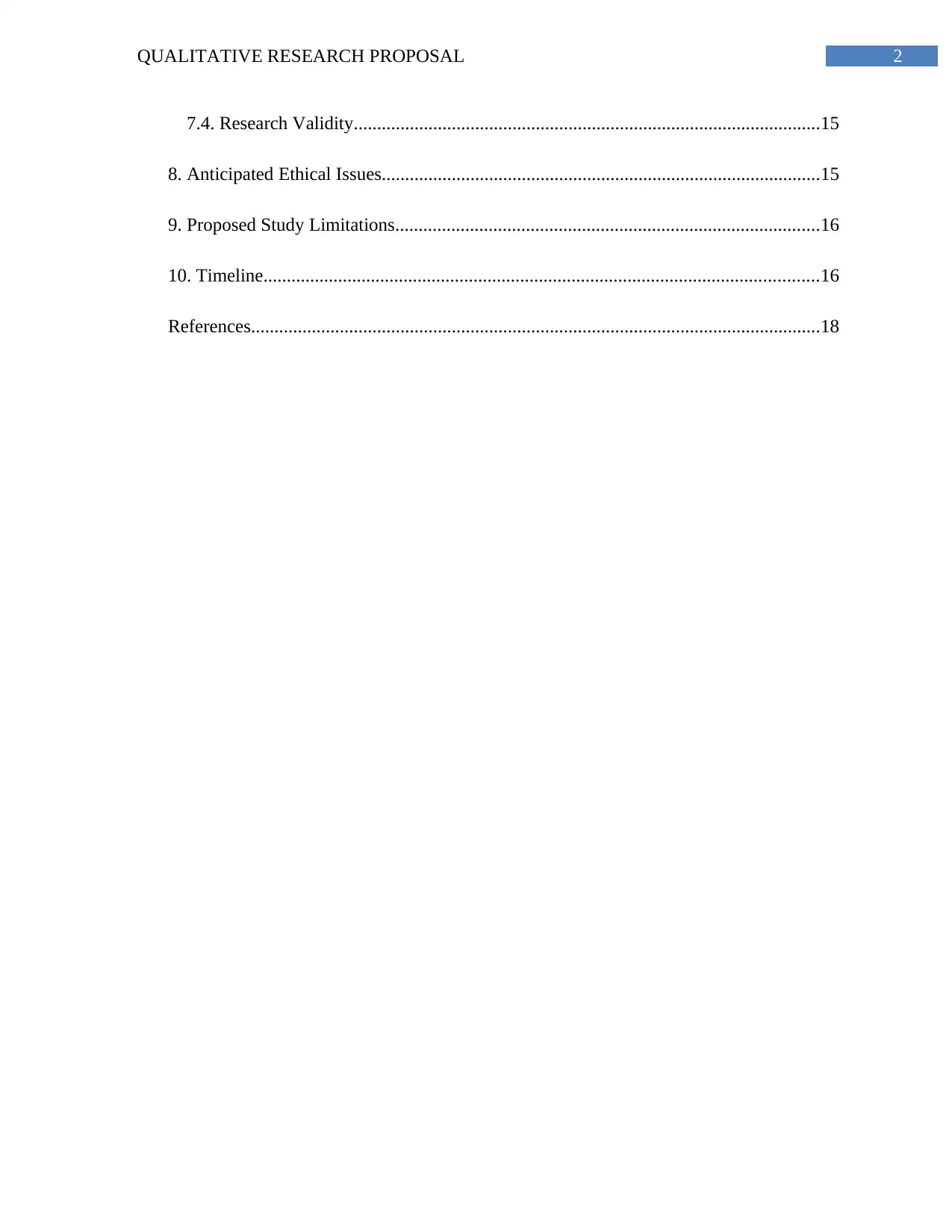
2QUALITATIVE RESEARCH PROPOSAL
7.4. Research Validity....................................................................................................15
8. Anticipated Ethical Issues..............................................................................................15
9. Proposed Study Limitations...........................................................................................16
10. Timeline.......................................................................................................................16
References..........................................................................................................................18
7.4. Research Validity....................................................................................................15
8. Anticipated Ethical Issues..............................................................................................15
9. Proposed Study Limitations...........................................................................................16
10. Timeline.......................................................................................................................16
References..........................................................................................................................18
⊘ This is a preview!⊘
Do you want full access?
Subscribe today to unlock all pages.

Trusted by 1+ million students worldwide
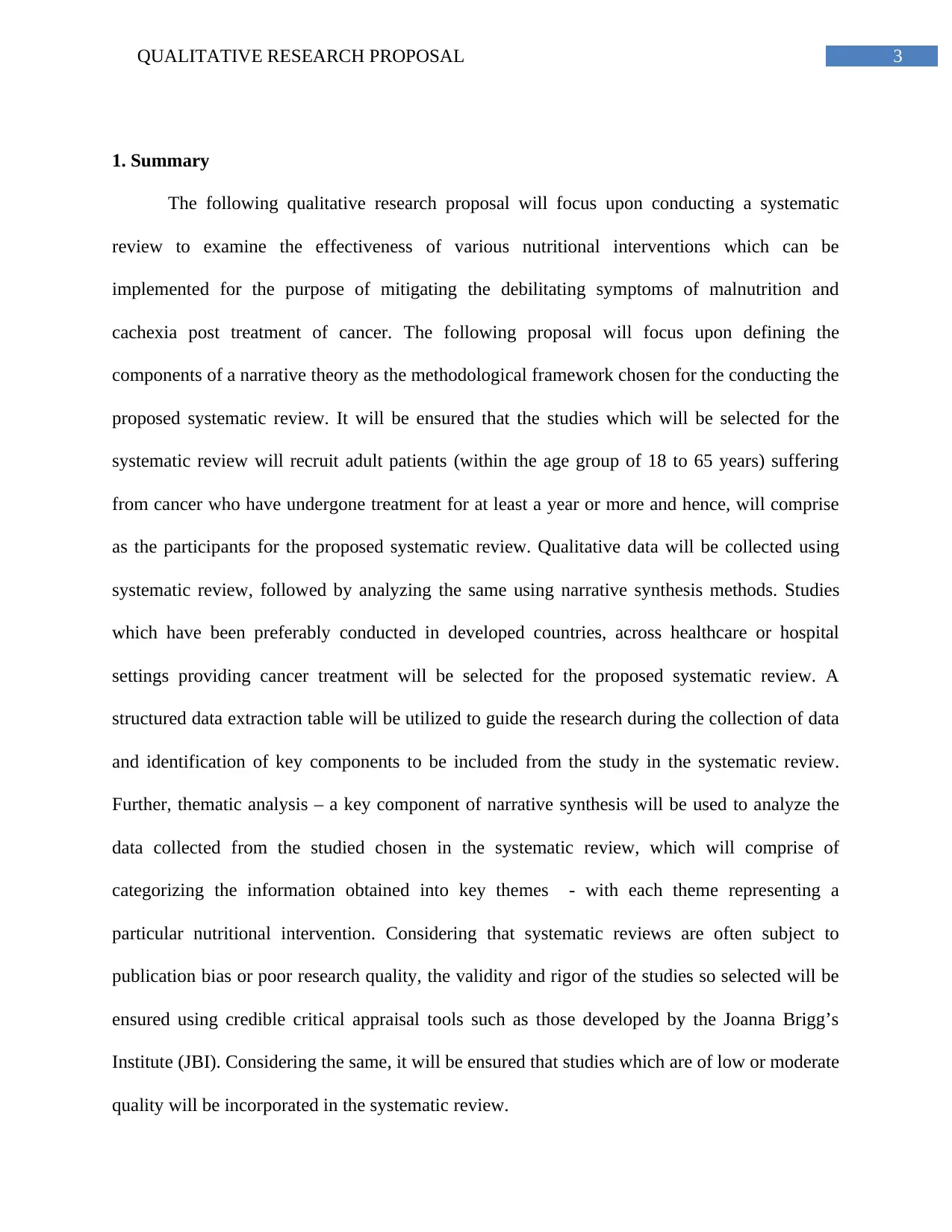
3QUALITATIVE RESEARCH PROPOSAL
1. Summary
The following qualitative research proposal will focus upon conducting a systematic
review to examine the effectiveness of various nutritional interventions which can be
implemented for the purpose of mitigating the debilitating symptoms of malnutrition and
cachexia post treatment of cancer. The following proposal will focus upon defining the
components of a narrative theory as the methodological framework chosen for the conducting the
proposed systematic review. It will be ensured that the studies which will be selected for the
systematic review will recruit adult patients (within the age group of 18 to 65 years) suffering
from cancer who have undergone treatment for at least a year or more and hence, will comprise
as the participants for the proposed systematic review. Qualitative data will be collected using
systematic review, followed by analyzing the same using narrative synthesis methods. Studies
which have been preferably conducted in developed countries, across healthcare or hospital
settings providing cancer treatment will be selected for the proposed systematic review. A
structured data extraction table will be utilized to guide the research during the collection of data
and identification of key components to be included from the study in the systematic review.
Further, thematic analysis – a key component of narrative synthesis will be used to analyze the
data collected from the studied chosen in the systematic review, which will comprise of
categorizing the information obtained into key themes - with each theme representing a
particular nutritional intervention. Considering that systematic reviews are often subject to
publication bias or poor research quality, the validity and rigor of the studies so selected will be
ensured using credible critical appraisal tools such as those developed by the Joanna Brigg’s
Institute (JBI). Considering the same, it will be ensured that studies which are of low or moderate
quality will be incorporated in the systematic review.
1. Summary
The following qualitative research proposal will focus upon conducting a systematic
review to examine the effectiveness of various nutritional interventions which can be
implemented for the purpose of mitigating the debilitating symptoms of malnutrition and
cachexia post treatment of cancer. The following proposal will focus upon defining the
components of a narrative theory as the methodological framework chosen for the conducting the
proposed systematic review. It will be ensured that the studies which will be selected for the
systematic review will recruit adult patients (within the age group of 18 to 65 years) suffering
from cancer who have undergone treatment for at least a year or more and hence, will comprise
as the participants for the proposed systematic review. Qualitative data will be collected using
systematic review, followed by analyzing the same using narrative synthesis methods. Studies
which have been preferably conducted in developed countries, across healthcare or hospital
settings providing cancer treatment will be selected for the proposed systematic review. A
structured data extraction table will be utilized to guide the research during the collection of data
and identification of key components to be included from the study in the systematic review.
Further, thematic analysis – a key component of narrative synthesis will be used to analyze the
data collected from the studied chosen in the systematic review, which will comprise of
categorizing the information obtained into key themes - with each theme representing a
particular nutritional intervention. Considering that systematic reviews are often subject to
publication bias or poor research quality, the validity and rigor of the studies so selected will be
ensured using credible critical appraisal tools such as those developed by the Joanna Brigg’s
Institute (JBI). Considering the same, it will be ensured that studies which are of low or moderate
quality will be incorporated in the systematic review.
Paraphrase This Document
Need a fresh take? Get an instant paraphrase of this document with our AI Paraphraser
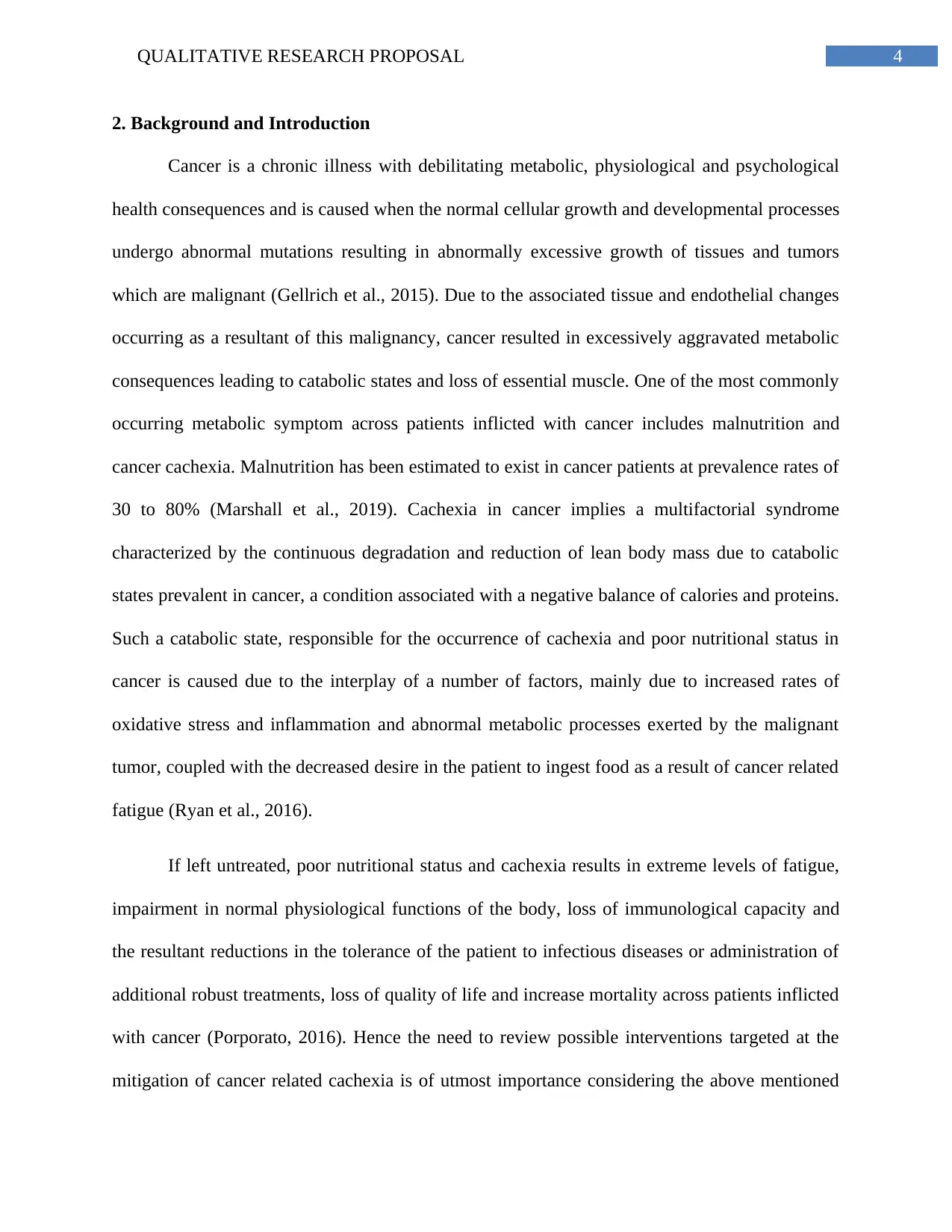
4QUALITATIVE RESEARCH PROPOSAL
2. Background and Introduction
Cancer is a chronic illness with debilitating metabolic, physiological and psychological
health consequences and is caused when the normal cellular growth and developmental processes
undergo abnormal mutations resulting in abnormally excessive growth of tissues and tumors
which are malignant (Gellrich et al., 2015). Due to the associated tissue and endothelial changes
occurring as a resultant of this malignancy, cancer resulted in excessively aggravated metabolic
consequences leading to catabolic states and loss of essential muscle. One of the most commonly
occurring metabolic symptom across patients inflicted with cancer includes malnutrition and
cancer cachexia. Malnutrition has been estimated to exist in cancer patients at prevalence rates of
30 to 80% (Marshall et al., 2019). Cachexia in cancer implies a multifactorial syndrome
characterized by the continuous degradation and reduction of lean body mass due to catabolic
states prevalent in cancer, a condition associated with a negative balance of calories and proteins.
Such a catabolic state, responsible for the occurrence of cachexia and poor nutritional status in
cancer is caused due to the interplay of a number of factors, mainly due to increased rates of
oxidative stress and inflammation and abnormal metabolic processes exerted by the malignant
tumor, coupled with the decreased desire in the patient to ingest food as a result of cancer related
fatigue (Ryan et al., 2016).
If left untreated, poor nutritional status and cachexia results in extreme levels of fatigue,
impairment in normal physiological functions of the body, loss of immunological capacity and
the resultant reductions in the tolerance of the patient to infectious diseases or administration of
additional robust treatments, loss of quality of life and increase mortality across patients inflicted
with cancer (Porporato, 2016). Hence the need to review possible interventions targeted at the
mitigation of cancer related cachexia is of utmost importance considering the above mentioned
2. Background and Introduction
Cancer is a chronic illness with debilitating metabolic, physiological and psychological
health consequences and is caused when the normal cellular growth and developmental processes
undergo abnormal mutations resulting in abnormally excessive growth of tissues and tumors
which are malignant (Gellrich et al., 2015). Due to the associated tissue and endothelial changes
occurring as a resultant of this malignancy, cancer resulted in excessively aggravated metabolic
consequences leading to catabolic states and loss of essential muscle. One of the most commonly
occurring metabolic symptom across patients inflicted with cancer includes malnutrition and
cancer cachexia. Malnutrition has been estimated to exist in cancer patients at prevalence rates of
30 to 80% (Marshall et al., 2019). Cachexia in cancer implies a multifactorial syndrome
characterized by the continuous degradation and reduction of lean body mass due to catabolic
states prevalent in cancer, a condition associated with a negative balance of calories and proteins.
Such a catabolic state, responsible for the occurrence of cachexia and poor nutritional status in
cancer is caused due to the interplay of a number of factors, mainly due to increased rates of
oxidative stress and inflammation and abnormal metabolic processes exerted by the malignant
tumor, coupled with the decreased desire in the patient to ingest food as a result of cancer related
fatigue (Ryan et al., 2016).
If left untreated, poor nutritional status and cachexia results in extreme levels of fatigue,
impairment in normal physiological functions of the body, loss of immunological capacity and
the resultant reductions in the tolerance of the patient to infectious diseases or administration of
additional robust treatments, loss of quality of life and increase mortality across patients inflicted
with cancer (Porporato, 2016). Hence the need to review possible interventions targeted at the
mitigation of cancer related cachexia is of utmost importance considering the above mentioned
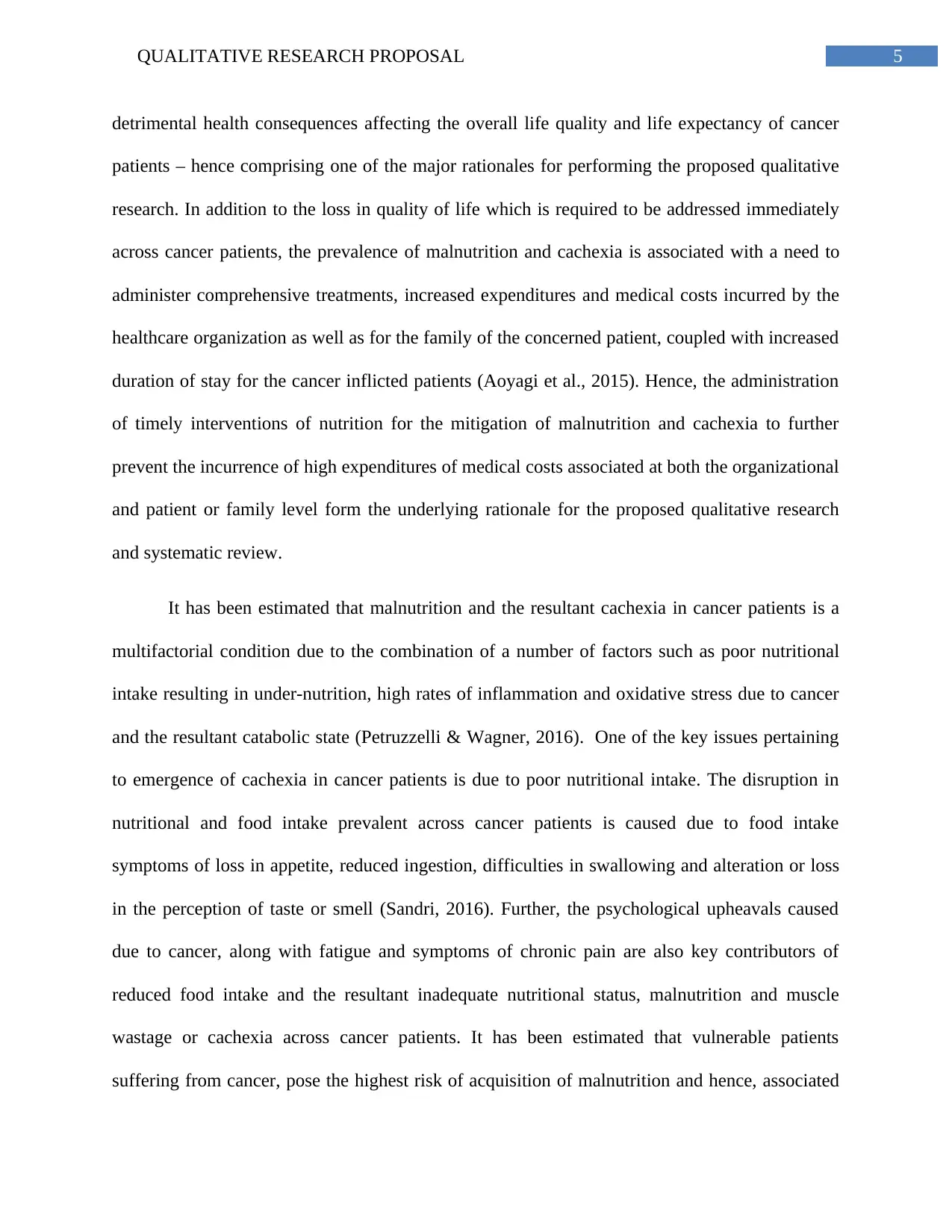
5QUALITATIVE RESEARCH PROPOSAL
detrimental health consequences affecting the overall life quality and life expectancy of cancer
patients – hence comprising one of the major rationales for performing the proposed qualitative
research. In addition to the loss in quality of life which is required to be addressed immediately
across cancer patients, the prevalence of malnutrition and cachexia is associated with a need to
administer comprehensive treatments, increased expenditures and medical costs incurred by the
healthcare organization as well as for the family of the concerned patient, coupled with increased
duration of stay for the cancer inflicted patients (Aoyagi et al., 2015). Hence, the administration
of timely interventions of nutrition for the mitigation of malnutrition and cachexia to further
prevent the incurrence of high expenditures of medical costs associated at both the organizational
and patient or family level form the underlying rationale for the proposed qualitative research
and systematic review.
It has been estimated that malnutrition and the resultant cachexia in cancer patients is a
multifactorial condition due to the combination of a number of factors such as poor nutritional
intake resulting in under-nutrition, high rates of inflammation and oxidative stress due to cancer
and the resultant catabolic state (Petruzzelli & Wagner, 2016). One of the key issues pertaining
to emergence of cachexia in cancer patients is due to poor nutritional intake. The disruption in
nutritional and food intake prevalent across cancer patients is caused due to food intake
symptoms of loss in appetite, reduced ingestion, difficulties in swallowing and alteration or loss
in the perception of taste or smell (Sandri, 2016). Further, the psychological upheavals caused
due to cancer, along with fatigue and symptoms of chronic pain are also key contributors of
reduced food intake and the resultant inadequate nutritional status, malnutrition and muscle
wastage or cachexia across cancer patients. It has been estimated that vulnerable patients
suffering from cancer, pose the highest risk of acquisition of malnutrition and hence, associated
detrimental health consequences affecting the overall life quality and life expectancy of cancer
patients – hence comprising one of the major rationales for performing the proposed qualitative
research. In addition to the loss in quality of life which is required to be addressed immediately
across cancer patients, the prevalence of malnutrition and cachexia is associated with a need to
administer comprehensive treatments, increased expenditures and medical costs incurred by the
healthcare organization as well as for the family of the concerned patient, coupled with increased
duration of stay for the cancer inflicted patients (Aoyagi et al., 2015). Hence, the administration
of timely interventions of nutrition for the mitigation of malnutrition and cachexia to further
prevent the incurrence of high expenditures of medical costs associated at both the organizational
and patient or family level form the underlying rationale for the proposed qualitative research
and systematic review.
It has been estimated that malnutrition and the resultant cachexia in cancer patients is a
multifactorial condition due to the combination of a number of factors such as poor nutritional
intake resulting in under-nutrition, high rates of inflammation and oxidative stress due to cancer
and the resultant catabolic state (Petruzzelli & Wagner, 2016). One of the key issues pertaining
to emergence of cachexia in cancer patients is due to poor nutritional intake. The disruption in
nutritional and food intake prevalent across cancer patients is caused due to food intake
symptoms of loss in appetite, reduced ingestion, difficulties in swallowing and alteration or loss
in the perception of taste or smell (Sandri, 2016). Further, the psychological upheavals caused
due to cancer, along with fatigue and symptoms of chronic pain are also key contributors of
reduced food intake and the resultant inadequate nutritional status, malnutrition and muscle
wastage or cachexia across cancer patients. It has been estimated that vulnerable patients
suffering from cancer, pose the highest risk of acquisition of malnutrition and hence, associated
⊘ This is a preview!⊘
Do you want full access?
Subscribe today to unlock all pages.

Trusted by 1+ million students worldwide
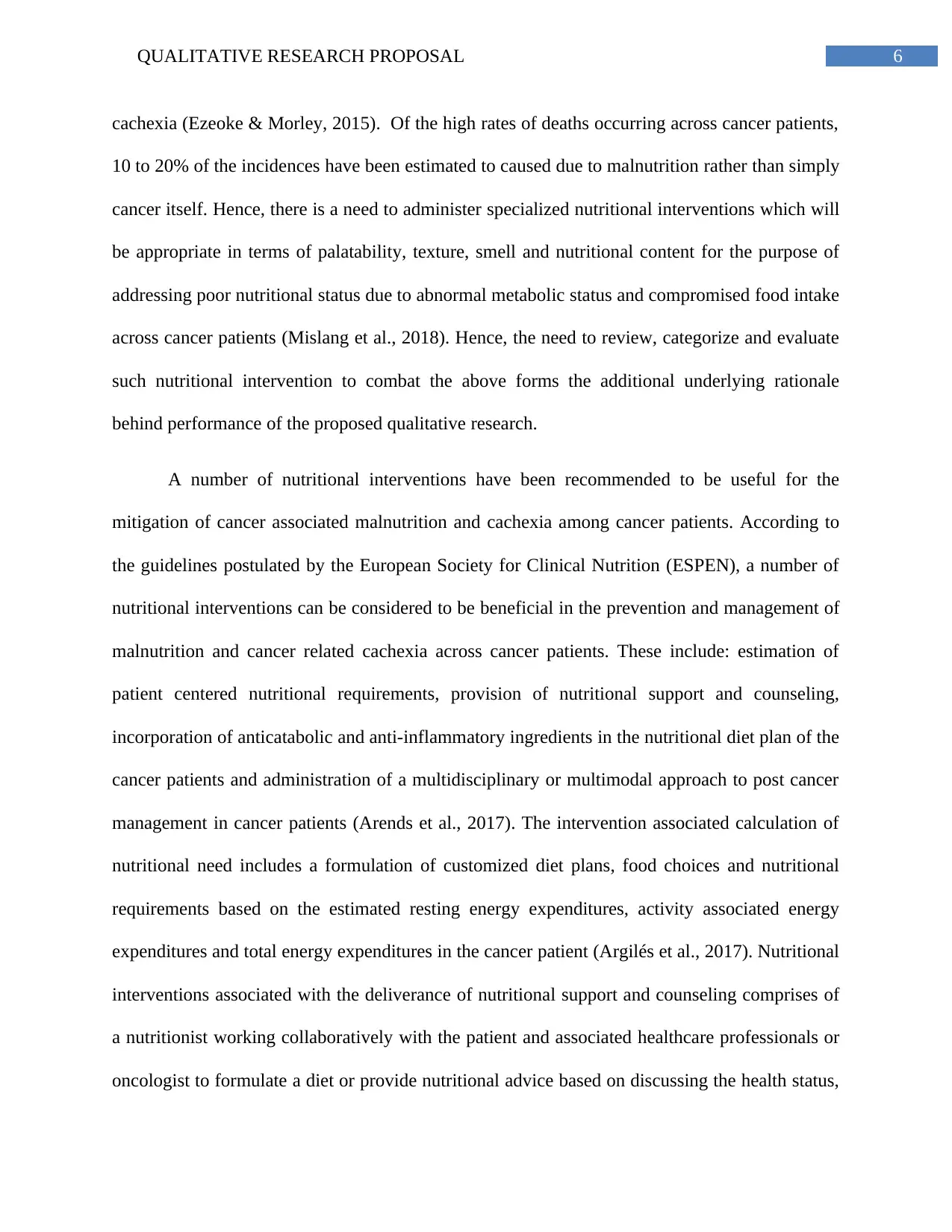
6QUALITATIVE RESEARCH PROPOSAL
cachexia (Ezeoke & Morley, 2015). Of the high rates of deaths occurring across cancer patients,
10 to 20% of the incidences have been estimated to caused due to malnutrition rather than simply
cancer itself. Hence, there is a need to administer specialized nutritional interventions which will
be appropriate in terms of palatability, texture, smell and nutritional content for the purpose of
addressing poor nutritional status due to abnormal metabolic status and compromised food intake
across cancer patients (Mislang et al., 2018). Hence, the need to review, categorize and evaluate
such nutritional intervention to combat the above forms the additional underlying rationale
behind performance of the proposed qualitative research.
A number of nutritional interventions have been recommended to be useful for the
mitigation of cancer associated malnutrition and cachexia among cancer patients. According to
the guidelines postulated by the European Society for Clinical Nutrition (ESPEN), a number of
nutritional interventions can be considered to be beneficial in the prevention and management of
malnutrition and cancer related cachexia across cancer patients. These include: estimation of
patient centered nutritional requirements, provision of nutritional support and counseling,
incorporation of anticatabolic and anti-inflammatory ingredients in the nutritional diet plan of the
cancer patients and administration of a multidisciplinary or multimodal approach to post cancer
management in cancer patients (Arends et al., 2017). The intervention associated calculation of
nutritional need includes a formulation of customized diet plans, food choices and nutritional
requirements based on the estimated resting energy expenditures, activity associated energy
expenditures and total energy expenditures in the cancer patient (Argilés et al., 2017). Nutritional
interventions associated with the deliverance of nutritional support and counseling comprises of
a nutritionist working collaboratively with the patient and associated healthcare professionals or
oncologist to formulate a diet or provide nutritional advice based on discussing the health status,
cachexia (Ezeoke & Morley, 2015). Of the high rates of deaths occurring across cancer patients,
10 to 20% of the incidences have been estimated to caused due to malnutrition rather than simply
cancer itself. Hence, there is a need to administer specialized nutritional interventions which will
be appropriate in terms of palatability, texture, smell and nutritional content for the purpose of
addressing poor nutritional status due to abnormal metabolic status and compromised food intake
across cancer patients (Mislang et al., 2018). Hence, the need to review, categorize and evaluate
such nutritional intervention to combat the above forms the additional underlying rationale
behind performance of the proposed qualitative research.
A number of nutritional interventions have been recommended to be useful for the
mitigation of cancer associated malnutrition and cachexia among cancer patients. According to
the guidelines postulated by the European Society for Clinical Nutrition (ESPEN), a number of
nutritional interventions can be considered to be beneficial in the prevention and management of
malnutrition and cancer related cachexia across cancer patients. These include: estimation of
patient centered nutritional requirements, provision of nutritional support and counseling,
incorporation of anticatabolic and anti-inflammatory ingredients in the nutritional diet plan of the
cancer patients and administration of a multidisciplinary or multimodal approach to post cancer
management in cancer patients (Arends et al., 2017). The intervention associated calculation of
nutritional need includes a formulation of customized diet plans, food choices and nutritional
requirements based on the estimated resting energy expenditures, activity associated energy
expenditures and total energy expenditures in the cancer patient (Argilés et al., 2017). Nutritional
interventions associated with the deliverance of nutritional support and counseling comprises of
a nutritionist working collaboratively with the patient and associated healthcare professionals or
oncologist to formulate a diet or provide nutritional advice based on discussing the health status,
Paraphrase This Document
Need a fresh take? Get an instant paraphrase of this document with our AI Paraphraser
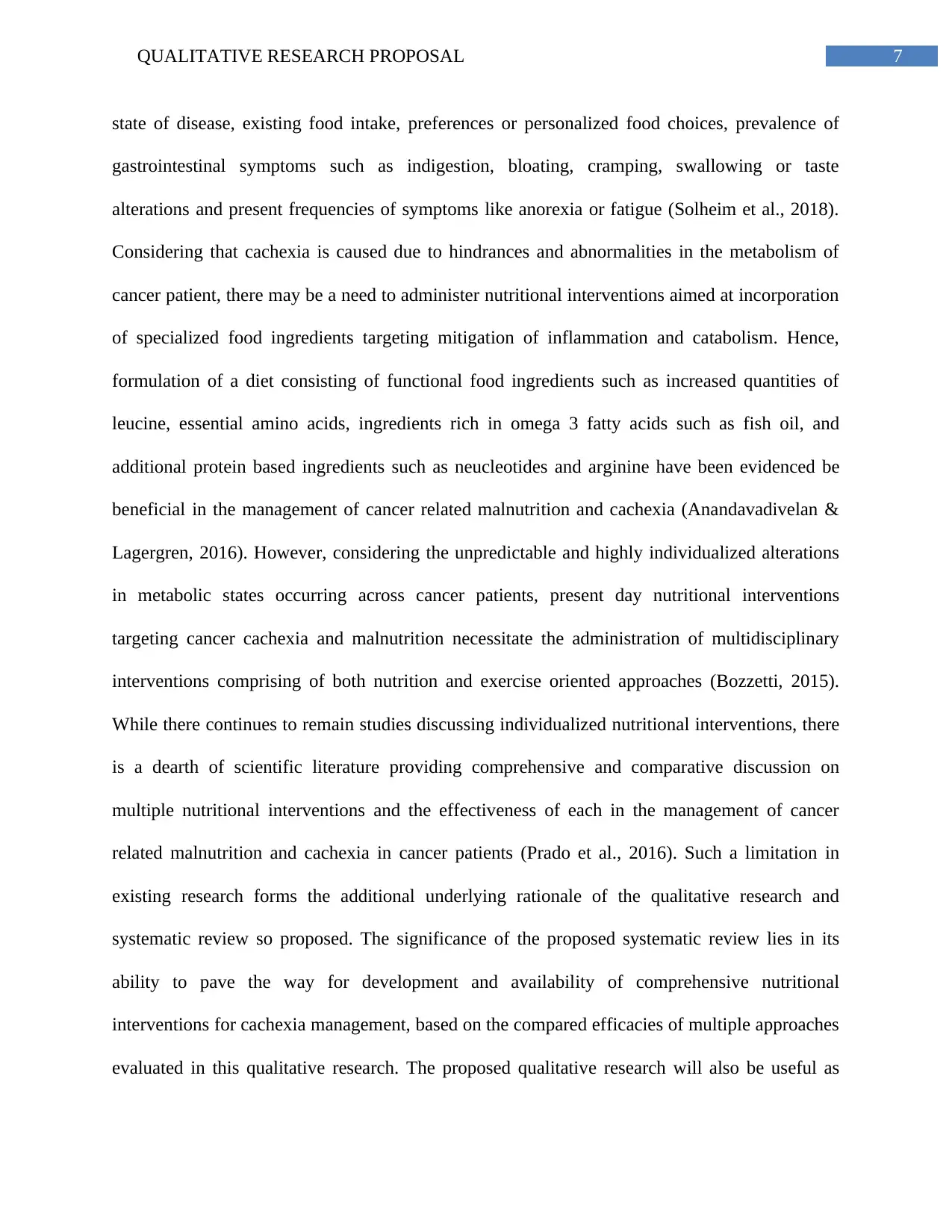
7QUALITATIVE RESEARCH PROPOSAL
state of disease, existing food intake, preferences or personalized food choices, prevalence of
gastrointestinal symptoms such as indigestion, bloating, cramping, swallowing or taste
alterations and present frequencies of symptoms like anorexia or fatigue (Solheim et al., 2018).
Considering that cachexia is caused due to hindrances and abnormalities in the metabolism of
cancer patient, there may be a need to administer nutritional interventions aimed at incorporation
of specialized food ingredients targeting mitigation of inflammation and catabolism. Hence,
formulation of a diet consisting of functional food ingredients such as increased quantities of
leucine, essential amino acids, ingredients rich in omega 3 fatty acids such as fish oil, and
additional protein based ingredients such as neucleotides and arginine have been evidenced be
beneficial in the management of cancer related malnutrition and cachexia (Anandavadivelan &
Lagergren, 2016). However, considering the unpredictable and highly individualized alterations
in metabolic states occurring across cancer patients, present day nutritional interventions
targeting cancer cachexia and malnutrition necessitate the administration of multidisciplinary
interventions comprising of both nutrition and exercise oriented approaches (Bozzetti, 2015).
While there continues to remain studies discussing individualized nutritional interventions, there
is a dearth of scientific literature providing comprehensive and comparative discussion on
multiple nutritional interventions and the effectiveness of each in the management of cancer
related malnutrition and cachexia in cancer patients (Prado et al., 2016). Such a limitation in
existing research forms the additional underlying rationale of the qualitative research and
systematic review so proposed. The significance of the proposed systematic review lies in its
ability to pave the way for development and availability of comprehensive nutritional
interventions for cachexia management, based on the compared efficacies of multiple approaches
evaluated in this qualitative research. The proposed qualitative research will also be useful as
state of disease, existing food intake, preferences or personalized food choices, prevalence of
gastrointestinal symptoms such as indigestion, bloating, cramping, swallowing or taste
alterations and present frequencies of symptoms like anorexia or fatigue (Solheim et al., 2018).
Considering that cachexia is caused due to hindrances and abnormalities in the metabolism of
cancer patient, there may be a need to administer nutritional interventions aimed at incorporation
of specialized food ingredients targeting mitigation of inflammation and catabolism. Hence,
formulation of a diet consisting of functional food ingredients such as increased quantities of
leucine, essential amino acids, ingredients rich in omega 3 fatty acids such as fish oil, and
additional protein based ingredients such as neucleotides and arginine have been evidenced be
beneficial in the management of cancer related malnutrition and cachexia (Anandavadivelan &
Lagergren, 2016). However, considering the unpredictable and highly individualized alterations
in metabolic states occurring across cancer patients, present day nutritional interventions
targeting cancer cachexia and malnutrition necessitate the administration of multidisciplinary
interventions comprising of both nutrition and exercise oriented approaches (Bozzetti, 2015).
While there continues to remain studies discussing individualized nutritional interventions, there
is a dearth of scientific literature providing comprehensive and comparative discussion on
multiple nutritional interventions and the effectiveness of each in the management of cancer
related malnutrition and cachexia in cancer patients (Prado et al., 2016). Such a limitation in
existing research forms the additional underlying rationale of the qualitative research and
systematic review so proposed. The significance of the proposed systematic review lies in its
ability to pave the way for development and availability of comprehensive nutritional
interventions for cachexia management, based on the compared efficacies of multiple approaches
evaluated in this qualitative research. The proposed qualitative research will also be useful as
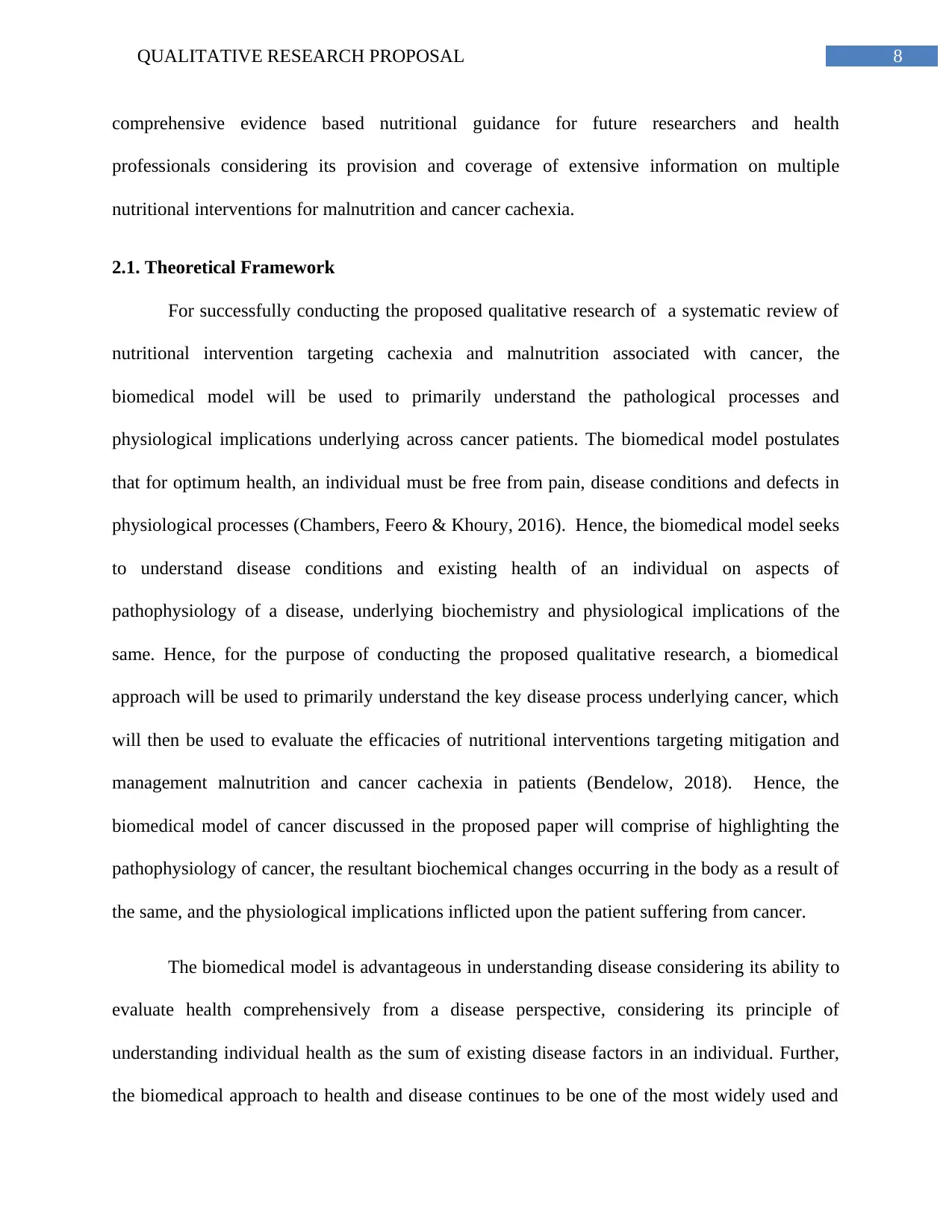
8QUALITATIVE RESEARCH PROPOSAL
comprehensive evidence based nutritional guidance for future researchers and health
professionals considering its provision and coverage of extensive information on multiple
nutritional interventions for malnutrition and cancer cachexia.
2.1. Theoretical Framework
For successfully conducting the proposed qualitative research of a systematic review of
nutritional intervention targeting cachexia and malnutrition associated with cancer, the
biomedical model will be used to primarily understand the pathological processes and
physiological implications underlying across cancer patients. The biomedical model postulates
that for optimum health, an individual must be free from pain, disease conditions and defects in
physiological processes (Chambers, Feero & Khoury, 2016). Hence, the biomedical model seeks
to understand disease conditions and existing health of an individual on aspects of
pathophysiology of a disease, underlying biochemistry and physiological implications of the
same. Hence, for the purpose of conducting the proposed qualitative research, a biomedical
approach will be used to primarily understand the key disease process underlying cancer, which
will then be used to evaluate the efficacies of nutritional interventions targeting mitigation and
management malnutrition and cancer cachexia in patients (Bendelow, 2018). Hence, the
biomedical model of cancer discussed in the proposed paper will comprise of highlighting the
pathophysiology of cancer, the resultant biochemical changes occurring in the body as a result of
the same, and the physiological implications inflicted upon the patient suffering from cancer.
The biomedical model is advantageous in understanding disease considering its ability to
evaluate health comprehensively from a disease perspective, considering its principle of
understanding individual health as the sum of existing disease factors in an individual. Further,
the biomedical approach to health and disease continues to be one of the most widely used and
comprehensive evidence based nutritional guidance for future researchers and health
professionals considering its provision and coverage of extensive information on multiple
nutritional interventions for malnutrition and cancer cachexia.
2.1. Theoretical Framework
For successfully conducting the proposed qualitative research of a systematic review of
nutritional intervention targeting cachexia and malnutrition associated with cancer, the
biomedical model will be used to primarily understand the pathological processes and
physiological implications underlying across cancer patients. The biomedical model postulates
that for optimum health, an individual must be free from pain, disease conditions and defects in
physiological processes (Chambers, Feero & Khoury, 2016). Hence, the biomedical model seeks
to understand disease conditions and existing health of an individual on aspects of
pathophysiology of a disease, underlying biochemistry and physiological implications of the
same. Hence, for the purpose of conducting the proposed qualitative research, a biomedical
approach will be used to primarily understand the key disease process underlying cancer, which
will then be used to evaluate the efficacies of nutritional interventions targeting mitigation and
management malnutrition and cancer cachexia in patients (Bendelow, 2018). Hence, the
biomedical model of cancer discussed in the proposed paper will comprise of highlighting the
pathophysiology of cancer, the resultant biochemical changes occurring in the body as a result of
the same, and the physiological implications inflicted upon the patient suffering from cancer.
The biomedical model is advantageous in understanding disease considering its ability to
evaluate health comprehensively from a disease perspective, considering its principle of
understanding individual health as the sum of existing disease factors in an individual. Further,
the biomedical approach to health and disease continues to be one of the most widely used and
⊘ This is a preview!⊘
Do you want full access?
Subscribe today to unlock all pages.

Trusted by 1+ million students worldwide
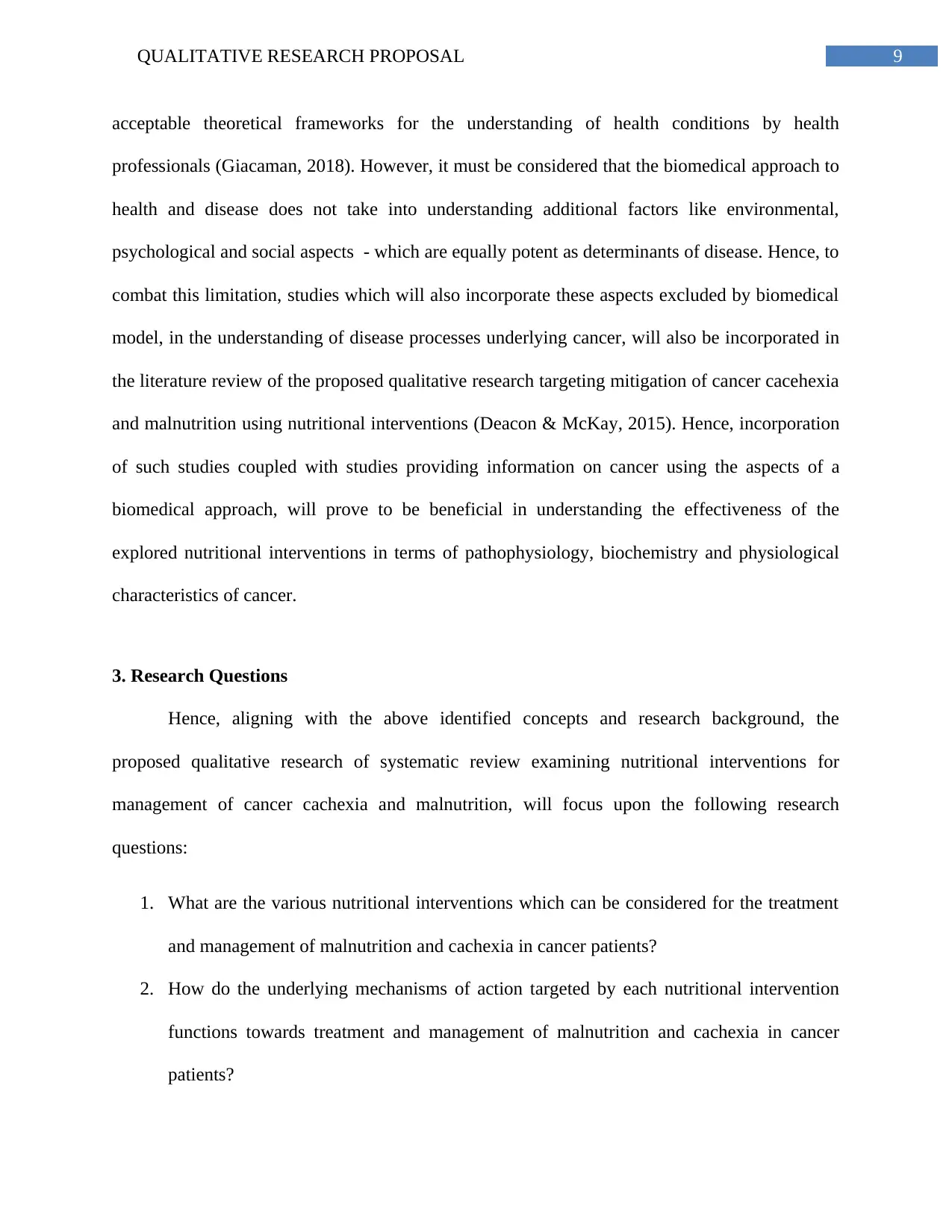
9QUALITATIVE RESEARCH PROPOSAL
acceptable theoretical frameworks for the understanding of health conditions by health
professionals (Giacaman, 2018). However, it must be considered that the biomedical approach to
health and disease does not take into understanding additional factors like environmental,
psychological and social aspects - which are equally potent as determinants of disease. Hence, to
combat this limitation, studies which will also incorporate these aspects excluded by biomedical
model, in the understanding of disease processes underlying cancer, will also be incorporated in
the literature review of the proposed qualitative research targeting mitigation of cancer cacehexia
and malnutrition using nutritional interventions (Deacon & McKay, 2015). Hence, incorporation
of such studies coupled with studies providing information on cancer using the aspects of a
biomedical approach, will prove to be beneficial in understanding the effectiveness of the
explored nutritional interventions in terms of pathophysiology, biochemistry and physiological
characteristics of cancer.
3. Research Questions
Hence, aligning with the above identified concepts and research background, the
proposed qualitative research of systematic review examining nutritional interventions for
management of cancer cachexia and malnutrition, will focus upon the following research
questions:
1. What are the various nutritional interventions which can be considered for the treatment
and management of malnutrition and cachexia in cancer patients?
2. How do the underlying mechanisms of action targeted by each nutritional intervention
functions towards treatment and management of malnutrition and cachexia in cancer
patients?
acceptable theoretical frameworks for the understanding of health conditions by health
professionals (Giacaman, 2018). However, it must be considered that the biomedical approach to
health and disease does not take into understanding additional factors like environmental,
psychological and social aspects - which are equally potent as determinants of disease. Hence, to
combat this limitation, studies which will also incorporate these aspects excluded by biomedical
model, in the understanding of disease processes underlying cancer, will also be incorporated in
the literature review of the proposed qualitative research targeting mitigation of cancer cacehexia
and malnutrition using nutritional interventions (Deacon & McKay, 2015). Hence, incorporation
of such studies coupled with studies providing information on cancer using the aspects of a
biomedical approach, will prove to be beneficial in understanding the effectiveness of the
explored nutritional interventions in terms of pathophysiology, biochemistry and physiological
characteristics of cancer.
3. Research Questions
Hence, aligning with the above identified concepts and research background, the
proposed qualitative research of systematic review examining nutritional interventions for
management of cancer cachexia and malnutrition, will focus upon the following research
questions:
1. What are the various nutritional interventions which can be considered for the treatment
and management of malnutrition and cachexia in cancer patients?
2. How do the underlying mechanisms of action targeted by each nutritional intervention
functions towards treatment and management of malnutrition and cachexia in cancer
patients?
Paraphrase This Document
Need a fresh take? Get an instant paraphrase of this document with our AI Paraphraser
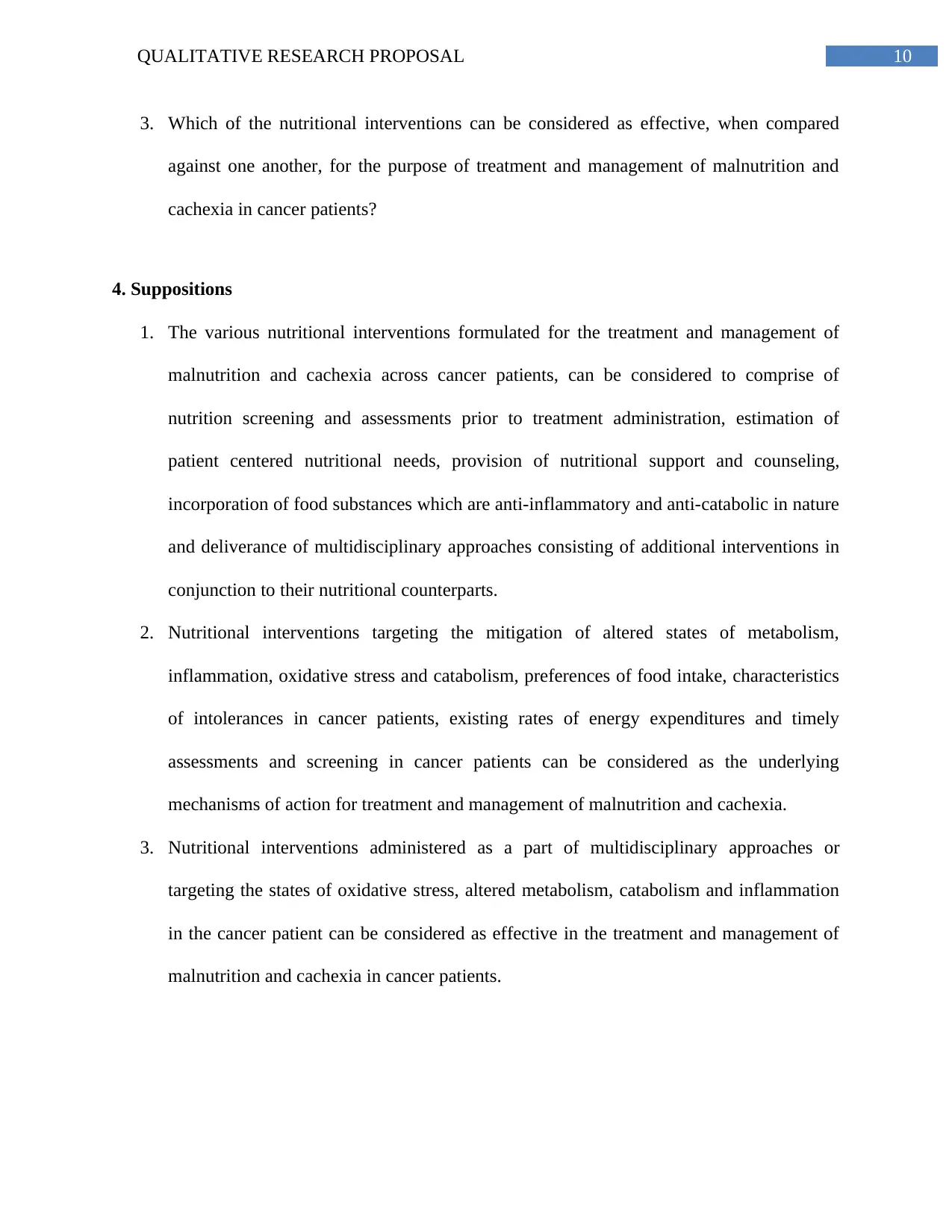
10QUALITATIVE RESEARCH PROPOSAL
3. Which of the nutritional interventions can be considered as effective, when compared
against one another, for the purpose of treatment and management of malnutrition and
cachexia in cancer patients?
4. Suppositions
1. The various nutritional interventions formulated for the treatment and management of
malnutrition and cachexia across cancer patients, can be considered to comprise of
nutrition screening and assessments prior to treatment administration, estimation of
patient centered nutritional needs, provision of nutritional support and counseling,
incorporation of food substances which are anti-inflammatory and anti-catabolic in nature
and deliverance of multidisciplinary approaches consisting of additional interventions in
conjunction to their nutritional counterparts.
2. Nutritional interventions targeting the mitigation of altered states of metabolism,
inflammation, oxidative stress and catabolism, preferences of food intake, characteristics
of intolerances in cancer patients, existing rates of energy expenditures and timely
assessments and screening in cancer patients can be considered as the underlying
mechanisms of action for treatment and management of malnutrition and cachexia.
3. Nutritional interventions administered as a part of multidisciplinary approaches or
targeting the states of oxidative stress, altered metabolism, catabolism and inflammation
in the cancer patient can be considered as effective in the treatment and management of
malnutrition and cachexia in cancer patients.
3. Which of the nutritional interventions can be considered as effective, when compared
against one another, for the purpose of treatment and management of malnutrition and
cachexia in cancer patients?
4. Suppositions
1. The various nutritional interventions formulated for the treatment and management of
malnutrition and cachexia across cancer patients, can be considered to comprise of
nutrition screening and assessments prior to treatment administration, estimation of
patient centered nutritional needs, provision of nutritional support and counseling,
incorporation of food substances which are anti-inflammatory and anti-catabolic in nature
and deliverance of multidisciplinary approaches consisting of additional interventions in
conjunction to their nutritional counterparts.
2. Nutritional interventions targeting the mitigation of altered states of metabolism,
inflammation, oxidative stress and catabolism, preferences of food intake, characteristics
of intolerances in cancer patients, existing rates of energy expenditures and timely
assessments and screening in cancer patients can be considered as the underlying
mechanisms of action for treatment and management of malnutrition and cachexia.
3. Nutritional interventions administered as a part of multidisciplinary approaches or
targeting the states of oxidative stress, altered metabolism, catabolism and inflammation
in the cancer patient can be considered as effective in the treatment and management of
malnutrition and cachexia in cancer patients.
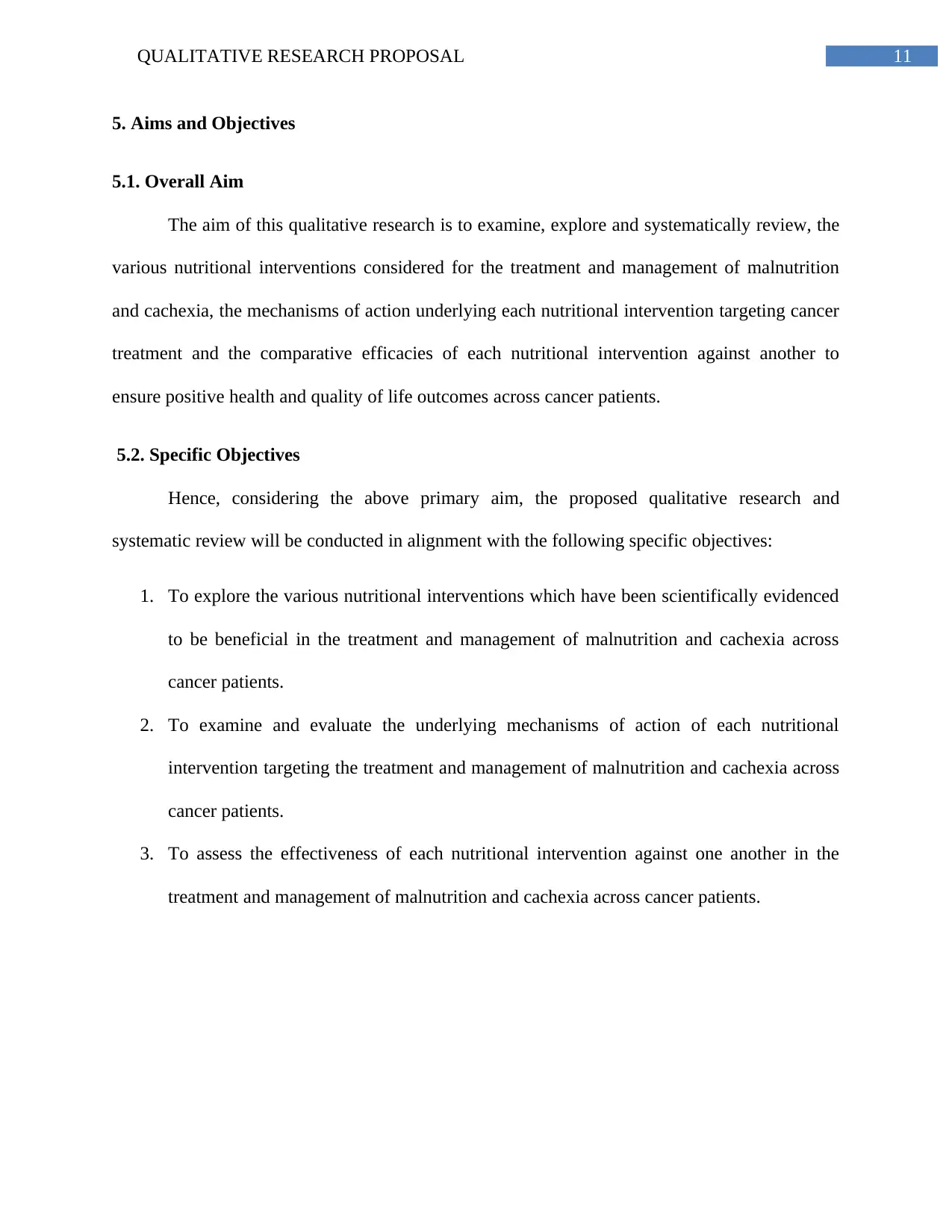
11QUALITATIVE RESEARCH PROPOSAL
5. Aims and Objectives
5.1. Overall Aim
The aim of this qualitative research is to examine, explore and systematically review, the
various nutritional interventions considered for the treatment and management of malnutrition
and cachexia, the mechanisms of action underlying each nutritional intervention targeting cancer
treatment and the comparative efficacies of each nutritional intervention against another to
ensure positive health and quality of life outcomes across cancer patients.
5.2. Specific Objectives
Hence, considering the above primary aim, the proposed qualitative research and
systematic review will be conducted in alignment with the following specific objectives:
1. To explore the various nutritional interventions which have been scientifically evidenced
to be beneficial in the treatment and management of malnutrition and cachexia across
cancer patients.
2. To examine and evaluate the underlying mechanisms of action of each nutritional
intervention targeting the treatment and management of malnutrition and cachexia across
cancer patients.
3. To assess the effectiveness of each nutritional intervention against one another in the
treatment and management of malnutrition and cachexia across cancer patients.
5. Aims and Objectives
5.1. Overall Aim
The aim of this qualitative research is to examine, explore and systematically review, the
various nutritional interventions considered for the treatment and management of malnutrition
and cachexia, the mechanisms of action underlying each nutritional intervention targeting cancer
treatment and the comparative efficacies of each nutritional intervention against another to
ensure positive health and quality of life outcomes across cancer patients.
5.2. Specific Objectives
Hence, considering the above primary aim, the proposed qualitative research and
systematic review will be conducted in alignment with the following specific objectives:
1. To explore the various nutritional interventions which have been scientifically evidenced
to be beneficial in the treatment and management of malnutrition and cachexia across
cancer patients.
2. To examine and evaluate the underlying mechanisms of action of each nutritional
intervention targeting the treatment and management of malnutrition and cachexia across
cancer patients.
3. To assess the effectiveness of each nutritional intervention against one another in the
treatment and management of malnutrition and cachexia across cancer patients.
⊘ This is a preview!⊘
Do you want full access?
Subscribe today to unlock all pages.

Trusted by 1+ million students worldwide
1 out of 23
Related Documents
Your All-in-One AI-Powered Toolkit for Academic Success.
+13062052269
info@desklib.com
Available 24*7 on WhatsApp / Email
![[object Object]](/_next/static/media/star-bottom.7253800d.svg)
Unlock your academic potential
Copyright © 2020–2025 A2Z Services. All Rights Reserved. Developed and managed by ZUCOL.





